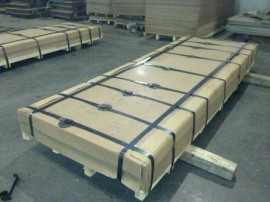
Is made of aluminum and aluminum alloy materials, construction products. Usually is first processed into castings, forgings and foil, plates, strips, tubes, rods, profiles, etc, then through cold bending, cutting, drilling, and coloring and made.
performance
Pure aluminium strength is low, their use is restricted. But add a small amount of one or several of alloy elements, such as magnesium, silicon, manganese, copper, zinc, iron, chromium, titanium, aluminum alloy with different properties can be. Aluminum alloy after cold working and heat treatment, further strengthened and hardened, its tensile strength is greatly increased.
Aluminium standard potential is 1.67 v, chemical nature very lively, easy with the oxygen in air to form a layer of dense solid oxide film, so in ordinary air and clean water, good corrosion resistance. But contact with steel or other metal materials will produce electrochemical corrosion, and concrete and cement mortar in the humid environment, such as lime alkaline material contact will produce corrosion, also can produce when in contact with wood, such as soil erosion. Therefore, it is necessary to properly anticorrosive processing.
Production methods
According to the production methods of different aluminum alloy, divided into two categories: casting aluminum alloy and deformation of aluminum alloy. General deformation of aluminum alloy on the building, to be used in rolling plate, foil and strip, squeeze into a bar, pipe, or all kinds of complicated shape profile. Deformation aluminium alloy according to their performance, USES different, divided into antirust aluminium alloy, hard aluminum, super-hard aluminum and special aluminum, etc. Commonly used in construction industry pure aluminum (L1 ~ L1), antirust aluminium alloy (LF2, LF21, etc.) and forging aluminum (LD2), etc.
Features and use
The biggest characteristic of aluminum and aluminum alloy, the first is its density is about 1/3 of the steel, and the intensity of than (the ratio of ultimate strength and weight) can reach or exceed structural steel. Second, aluminum and aluminum alloy is easy to be processed into various shapes, can adapt to all kinds of connection technology, for the building structure using the most economic and reasonable form of section provides favorable conditions. So, the use of aluminum alloy not only can greatly reduce the weight of the building, saving materials, but also can reduce component transportation and installation work, speed up the construction progress. For the earthquake zone and inaccessible mountains and remote areas, its economic effect is more significant. Aluminium and aluminium alloy and beautiful color, good corrosion resistance, heat and light of high reflectivity, sound-absorbing performance is good, can be obtained by using the method of chemical and electrochemical all sorts of different color. So aluminum is widely used in industrial and civil architecture roofing, inside and outside walls, doors and Windows, skeleton, decorative board, ceiling, ceiling, handrail, indoor furniture, shops and construction with the template.
Construction industry is one of the three major market aluminum, about 20% of the total aluminium production in the world for use in construction, the construction of some industrial developed countries, the amount of aluminum have accounted for more than 30% of its total production. In recent years, the construction of aluminum products constantly updated, color aluminum plate, composite aluminum plate, composite door, window frame, the application of the new building products such as aluminum alloy template also increased year by year. China has used in industrial and civil building roof, walls, doors and Windows, aluminium alloy and so on, and gradually spread to inside and outside decoration and construction with templates, etc., have achieved good results.








